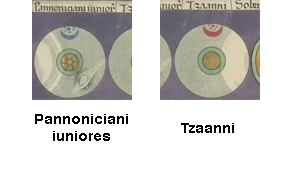
This page created 14 September 2014, and last modified: 26 July 2015 (San Giovanni image added)

The 16th of the legiones comitatenses under the Magister Militum per Thracias is listed (18.27 in Ingo Maier's numbering scheme) as the Taanni (M), Tannni (P), or THANNI (B; according to Seeck, Taanni in O, Thaanni in T). Its shield pattern (17#11) as shown in various manuscripts, under the label (17.l) Tzaanni (O), Tzaani (P), Taanni (M), or Thaanni (B; according to Seeck, Taanni in T), is as below:

The shield pattern has a white main field featuring a red crescent at the 12 o'clock position, cusps upwards. Between the crescent and the edge of the shield (which has no delineated rim) is a partial rosette of 5 red dots (but a full rosette of 6 dots in B, and in which the crescent is larger than in the other manuscripts). The boss is yellow (white in W) and encircled by a blue band (faded to yellow in M, and red in B). The shield pattern is this very similar to that of the preceding unit, the Pannoniciani iuniores (18.26), as can be seen below from the following patterns (below left) taken from the Paris manuscript; presumably they were brigaded together:

|
The motif of an upturned crescent in the 12 o'clock position as a shield emblem is carried by several other units in the Notitia, e.g. the Matiarii seniores (12.16), the Matiarii iuniores (9.22), and the eastern Batavi seniores (9.24). It is, however, not restricted to units depicted in the Notitia. To the right is my interpretation of a fresco painted on a wall of the catacombs of San Giovanni in Syracuse, Italy. A crescent with horns turned upward can be clearly made out on the soldier's shield; it is yellow in the original, albeit badly damaged by pitting (the main ground of the shield is white). The damage to the fresco makes it unclear what smaller charge is shown (if any) between and above the horns of the crescent. That the painting appears to accurately depict a soldier with equipment contemporary (or roughly contemporary) with the Notitia can be seen by looking at the helmet, which well depicts an "Intercisa"-style example. The San Giovanni shield pattern also shows a pillar beneath the boss (which is yellow, perhaps representing a copper alloy; the shield's rim is shown in the same colour); the pillar is a dark colour, perhaps purple, and there is some sort of flowing motif in yellow to the left and right of the boss that does not correspond well to any of the patterns found in the Notitia. |

|
The various manuscripts give divergent names for this unit, which is very un-Roman. Examples featuring a "z" are to be preferred, because then the name carries a clear meaning: it refers to a people from the south-west of the Caucasus, which might be called the Suani in the 1st century (e.g. Pliny NH 6.12), and Tzanni by the 6th century in Procopius (DB 4.1); they spoke a Zan language. Presumably the unit was recruited from the area they lived in, although the exact region seems to have moved north-east with time; in Pliny's day they lived in the Pontus, near modern Trabzon, but in Procopius' day, near what is the modern Turkish-Georgian border. This unit is undoubtably the Legio Zianni mentioned by Ammianus (25.1.19), and whose commander was killed during Julian's Persian invasion. It may be they were an offshoot of the only legion habitually deployed in the area, Legio I Pontica, in the Notitia stationed (71.7) at Trapezunta (modern Trabzon) under the Dux Armeniae.
Another unit named after the Tza(an)ni people in the Notitia is the Cohors nona Tzanorum, a (presumably auxiliary) cohort under (56/7.41) the Dux Thebaidos. That it is the "ninth" such cohort need not imply there were another eight cohorts so-named, as newly-raised units were often numbered in a sequence that ignored names but took into account the numbers of the units already stationed in the province to which they were to be stationed.

Return to the Notitia alphabetical unit list page.
Return to my Notitia index page.